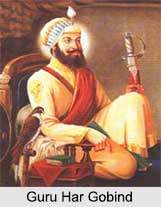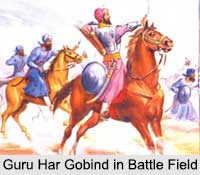 Guru Har Gobind also known as the "Sacha Padshah" was the sixth guru of the Sikhs. He had succeeded his father Guru Arjan Dev on 25th May, 1606. He was made a guru at the tender age of eleven. Guru Har Gobind had the elements of a soldier and a sportsman combined in his personality apart from the saintliness which was an integral part of his life. At a very early age he had realised that it was not enough to practice saintliness, in times of need one has to be tough.
Guru Har Gobind also known as the "Sacha Padshah" was the sixth guru of the Sikhs. He had succeeded his father Guru Arjan Dev on 25th May, 1606. He was made a guru at the tender age of eleven. Guru Har Gobind had the elements of a soldier and a sportsman combined in his personality apart from the saintliness which was an integral part of his life. At a very early age he had realised that it was not enough to practice saintliness, in times of need one has to be tough.
Early Life of Guru Har Gobind
Guru Har Gobind was born on 19th June, 1595 in the Wadali village. He was the only son of Guru Arjan Dev. From a very early age, Har Gobind was trained in various sciences, sports and religious studies. His learning took place under the care of Baba Buddha according to the instruction of Guru Arjan Dev.
Ideology of Guru Har Gobind
It is referred in history that during the Guruship ceremony, Har Gobind humbly refused to wear the "Seli", which was a woollen cord worn on the head. Before Har Gobind all the other gurus had accepted the Seli as a symbol of Guruship. Har Gobind instead asked for a sword. Baba Buddha having never handled a sword gave the sword to the guru in the wrong side and at this juncture, the guru asked for another sword to wear on the other side. From this time Guru Har Gobind decided that a guru should carry two swords with him as symbols of Bhakti and Shakti.
Guru Har Gobind was the physically strongest guru of the Sikhs. He as a person was a wonderful martial artist and a keen hunter. He emphasised on the physical fitness of his devotees. Guru Har Gobind had enhanced the military strength of Punjab. It is true that Guru Har Gobind had introduced warfare into the Sikh community but he never moved away from the ideologies of Guru Nanak and led a pure and righteous life close to the Sikh religious philosophy.
Conquests of Guru Har Gobind with Mughals
Guru Har Gobind had introduced the military concept within the Sikh Community because he had realised that the then circumstances had become adverse for the Sikhs. The Mughal rulers after Akbar, namely, Jahangir and Shah Jahan could not tolerate the spread of Sikhism and as a result they executed the Sikh gurus. Guru Arjan Dev met a sad end at the hand of Mughal rulers and Guru Har Gobind was taken a prisoner by the Mughals.
Foundations of Guru Har Gobind
Soon after becoming a guru, he built a new temple known as the Akal Takht in Amritsar. The Akal Takht was built facing the Golden Temple. Akal Takht had the same temporal authority as the Golden Temple had spiritual authority. The sixth guru had a throne built for him in the Akal Takht and he managed the matters of the Sikh community being seated on the throne. As he introduced a kind of royal structure in the Akal Takht, he came to be known as the "Sacha Padshah" by the Sikhs.
Guru Har Gobind had found the city of Kiratpur in the Jalandhar district. It was he who had inspired the members of the Sikh community to be instrumental in protecting the identity of their community.









